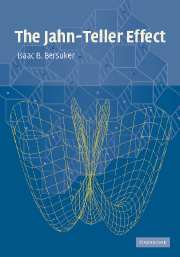Book contents
- Frontmatter
- Contents
- Preface
- Abbreviations
- 1 Introduction
- 2 Vibronic interactions
- 3 Formulation of Jahn–Teller problems. Adiabatic potentials
- 4 Pseudo Jahn–Teller, product Jahn–Teller, and Renner–Teller effects
- 5 Solutions of vibronic equations. Energy spectra and JT dynamics
- 6 The JTE in spectroscopy: general theory
- 7 Geometry, spectra, and reactivity of molecular systems
- 8 Solid-state problems: local properties and cooperative phenomena
- Appendix
- Subject index
- Formula index
Preface
Published online by Cambridge University Press: 07 December 2009
- Frontmatter
- Contents
- Preface
- Abbreviations
- 1 Introduction
- 2 Vibronic interactions
- 3 Formulation of Jahn–Teller problems. Adiabatic potentials
- 4 Pseudo Jahn–Teller, product Jahn–Teller, and Renner–Teller effects
- 5 Solutions of vibronic equations. Energy spectra and JT dynamics
- 6 The JTE in spectroscopy: general theory
- 7 Geometry, spectra, and reactivity of molecular systems
- 8 Solid-state problems: local properties and cooperative phenomena
- Appendix
- Subject index
- Formula index
Summary
The Jahn–Teller effect (JTE) is one of the most fascinating phenomena in modern physics and chemistry. It emerged in 1934 in a discussion between two famous physicists, L. Landau and E. Teller, and grew into a general tool for understanding and an approach to solving molecular and crystal problems, which is applicable to any polyatomic system. The first formulation of this effect as instability of molecular configurations in electronically degenerate states proved to be the beginning of a whole trend which rationalizes the origin of all possible instabilities of high-symmetry configurations, and the peculiar nuclear dynamics resulting from these instabilities as well as the origins of all structural symmetry breakings in molecular systems and condensed matter.
Intensive development of the JTE theory began in the late 1950s together with a wave of main applications to spectroscopy, stereochemistry, and structural phase transitions, which lasted a couple of decades. The next significant resurgence of interest in the Jahn–Teller effect is related to the late 1980s and is still continuing. It was triggered by one of the most important Nobel Prize discoveries in physics of our times inspired by the Jahn–Teller effect: the high-temperature superconductivity. As explained by the authors of this discovery, “the guiding idea in developing this concept was influenced by the Jahn–Teller polaron model” (J. G. Bednorz and K. A. Müller, in Nobel Lectures: Physics, Ed. G. Ekspong, World Scientific, Singapore, 1993, p. 424).
- Type
- Chapter
- Information
- The Jahn-Teller Effect , pp. xi - xivPublisher: Cambridge University PressPrint publication year: 2006



